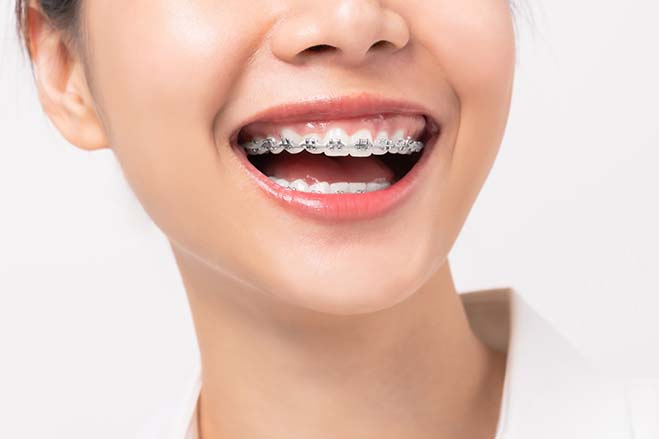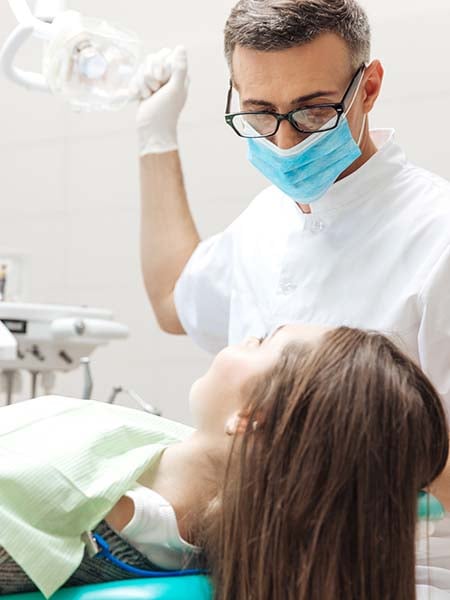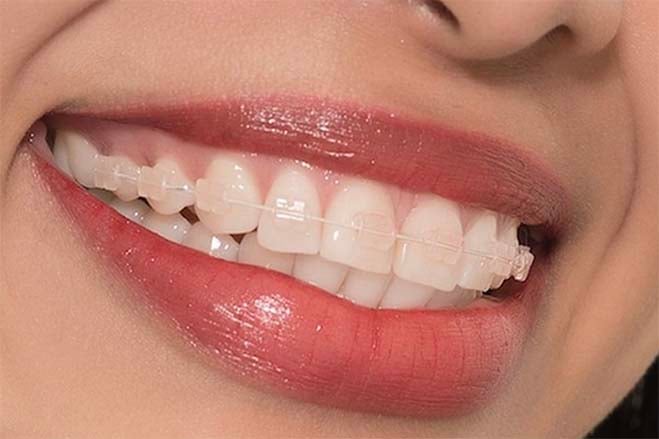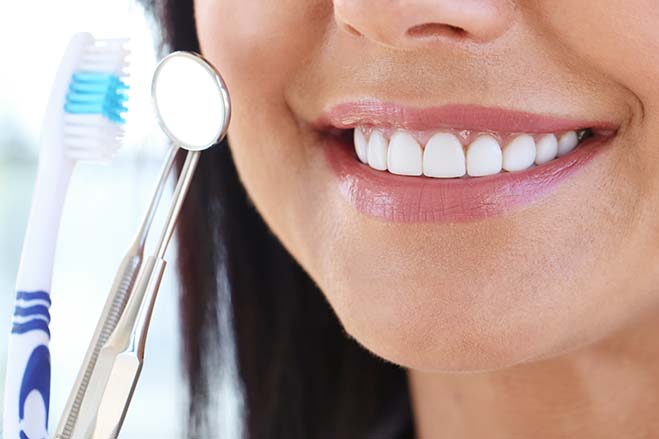Here are some of the key benefits of braces:
.svg)
.svg)
.svg)
.svg)

Braces Singapore
In Singapore, the cost of braces can vary widely depending on the type of braces and the orthodontist's fees. According to the Singapore Dental Association, the average cost of braces ranges from $3,500 to $7,000.
What Are Braces?

What Are Braces?
Braces are orthodontic devices that are used to correct misaligned teeth, bite issues, and jaw problems. They are commonly used for people of all ages, including teenagers and adults. Braces apply constant pressure on the teeth, gradually moving them into the correct position over time.
According to a survey conducted by the Singapore Dental Association, nearly 80% of children in Singapore need some.

Benefits of Braces
Types of Braces
It's essential to know about the different types of braces available when making the decision either for yourself or your child. The most common types of braces are metal braces, ceramic braces, lingual braces, and self-ligating braces. Each of these types has its benefits and drawbacks, depending on your orthodontic needs.
Before we dive into the details, here’s a table with the key differences between each type of braces that are commonly available at dental clinics in Singapore.
| Type of Braces | Appearance | Cost | Comfort | Treatment Time* | Cleaning |
| Metal braces | Highly visible, made of metal brackets and wires | $ | May cause discomfort, especially during adjustments | 18-36 months | Require extra care to clean properly |
| Ceramic braces | Less visible than metal braces, made of clear or tooth-colored brackets and wires | $$ | May cause discomfort, especially during adjustments | 18-36 months | Require extra care to clean properly |
| Lingual braces | Completely hidden from view, attached to the back of the teeth | $$$$$ | May cause discomfort, especially during the initial adjustment period | 24-36 months | Require extra care to clean properly |
| Self-ligating braces | Similar appearance to traditional braces, but with a different mechanism to hold the wire in place | $$$ | Generally more comfortable than traditional braces | 18-30 months | Require regular cleaning, but may be easier to keep clean than traditional braces |
*Treatment time is only meant as a reference and can vary depending on the severity of the patient’s bite
Traditional metal braces
Traditional braces consist of metal brackets and wires that are attached to the teeth. They are the most common type of braces, and they are very effective at correcting even severe misalignment problems. However, they are also very visible, and some people may find them uncomfortable to wear. Below are the pros and cons of traditional metal braces.
Pros:
Effective: Metal braces are very effective at correcting a wide range of orthodontic issues, including overcrowding, spacing, and bite problems.
Affordable: Metal braces are usually the most affordable type of braces, making them a popular option for many patients.
Durable: Metal braces are made of high-quality materials and are very durable, so they can withstand the wear and tear of daily use.
Predictable: Metal braces have been used for decades, so orthodontists have a lot of experience with them, making the treatment process very predictable.
Pros:

Cons:
Visible: Metal braces are very visible, so they may not be the best option for patients who are self-conscious about their appearance.
Discomfort: Metal braces can be uncomfortable, especially during the first few days after they are placed or after they are adjusted.
Maintenance: Metal braces require regular maintenance, including adjustments and cleaning, which can be time-consuming.
Oral hygiene: Maintaining good oral hygiene can be more difficult with metal braces, as food particles can get stuck in the brackets and wires.
Cons:

Potential risks and what to look out for in metal braces
- Tooth decay: Metal braces can make it harder to clean your teeth, which can lead to tooth decay if proper oral hygiene is not maintained.
- Gum disease: As with tooth decay, poor oral hygiene can lead to gum disease, which can cause inflammation, bleeding, and pain.
- Mouth sores: The brackets and wires of metal braces can irritate the mouth and cause sores to form.
- Allergic reactions: Some patients may be allergic to the metal in the braces or the adhesive used to attach them to the teeth.
- Damage to teeth: In rare cases, the brackets or wires of metal braces can come loose and cause damage to the teeth or gums.
- Discomfort: Metal braces can be uncomfortable, especially during the first few days after they are placed or after they are adjusted.
Potential risks and what to look out for in metal braces

Ceramic braces
Ceramic braces are similar to metal braces, but the brackets are made of clear or tooth-coloured material. They blend in with the teeth and are less noticeable than metal braces. However, ceramic braces are more expensive than metal braces and can stain if not cared for properly.
Ceramic braces are similar to metal braces, but they have clear or tooth-coloured brackets and wires that make them less noticeable. Here are some of the pros and cons of ceramic braces:
Pros:
Aesthetics: Ceramic braces are less noticeable than metal braces, which can make them a more attractive option for some people.
Comfort: Ceramic braces are usually more comfortable than metal braces because the brackets are smoother and less likely to irritate the mouth.
Effective: Ceramic braces are just as effective as metal braces in correcting dental problems.
Pros:

Cons:
Cost: Ceramic braces are generally more expensive than metal braces. Fragility: Ceramic braces are more brittle than metal braces, which can make them more prone to breaking or chipping.
Staining: The clear or tooth-coloured brackets of ceramic braces can become stained over time, especially if the patient smokes, drinks coffee or tea, or eats certain foods. It's important to discuss the pros and cons of ceramic braces with your orthodontist to determine whether they are the right choice for you. While they may be a more attractive option for some patients, they may not be the most practical choice for others.
Cons:

Potential risks and what to look out for in ceramic braces
- Fragility: Ceramic braces are more brittle than metal braces, which can make them more prone to breaking or chipping. Patients with ceramic braces should avoid biting hard or crunchy foods, using their teeth to open packaging, or playing contact sports without wearing a mouthguard.
- Staining: The clear or tooth-coloured brackets of ceramic braces can become stained over time, especially if the patient smokes, drinks coffee or tea, or eats certain foods. Patients with ceramic braces should be diligent about maintaining good oral hygiene, including brushing and flossing regularly, to prevent staining.
- Discomfort: Like metal braces, ceramic braces can cause some discomfort or soreness in the mouth, especially after adjustments. Patients can use over-the-counter pain relievers or apply a warm compress to the affected area to alleviate discomfort.
- Length of treatment: Depending on the severity of the dental problem, treatment with ceramic braces may take longer than with metal braces.
- Cost: Ceramic braces are generally more expensive than metal braces, which can be a consideration for some patients.
Potential risks and what to look out for in ceramic braces

Lingual Braces
Lingual braces are attached to the back of the teeth, making them virtually invisible from the front. They are a good option for people who want to straighten their teeth without the appearance of traditional braces. However, they can be difficult to clean and may be more uncomfortable to wear than other types of braces.
Pros:
Aesthetics: Lingual braces are virtually invisible from the front, making them a good option for patients who want to straighten their teeth without the look of traditional braces.
Customization: Because lingual braces are custom-made for each patient, they can be more effective at correcting complex dental issues than other types of braces.
Comfort: Lingual braces are designed to fit the contours of the teeth, which can make them more comfortable to wear than traditional braces.
Speech: Because lingual braces are on the back of the teeth, they may not interfere with speech as much as traditional braces.
Pros:

Cons:
Difficulty of cleaning: Because lingual braces are attached to the back of the teeth, they can be more difficult to clean than other types of braces. Patients with lingual braces may need to use special tools to clean between the brackets and wires.
Discomfort: Because the brackets and wires of lingual braces are attached to the tongue side of the teeth, they can cause discomfort or soreness in the mouth, especially after adjustments.
Length of treatment: Depending on the severity of the dental problem, treatment with lingual braces may take longer than with other types of braces.
Cost:Lingual braces are generally more expensive than traditional braces or ceramic braces, which can be a consideration for some patients.
Cons:

Potential risks and what to look out for in lingual braces
- Tongue irritation: The brackets and wires of lingual braces are attached to the back of the teeth, which can cause irritation to the tongue, especially during the first few weeks of treatment.
- Difficulty speaking: Since the braces are attached to the back of the teeth, it can take some time to adjust to speaking with them. This may cause temporary difficulty in pronouncing certain words or sounds.
- Increased difficulty in oral hygiene: Cleaning teeth with lingual braces is more challenging than with other types of braces, as the brackets and wires are harder to access. This can increase the risk of cavities and gum disease.
- Longer treatment time: Lingual braces may require a longer treatment time than other types of braces.
- Higher cost: Lingual braces can be more expensive than traditional metal braces or ceramic braces.
Potential risks and what to look out for in lingual braces

Self-ligating braces
Self-ligating braces (such as Damon Braces) are a type of orthodontic treatment that use a special bracket design to straighten teeth. Unlike traditional braces that use elastic bands to hold the wire in place, self-ligating braces use a sliding mechanism that allows the wire to move more freely. This can result in less friction, faster treatment times, and fewer adjustments needed over the course of treatment. Self-ligating braces can be made from metal or ceramic materials and may be a good option for those looking for a more discreet treatment option.
Pros:
Faster treatment time: Self-ligating braces can often result in a shorter treatment time, as they are designed to move teeth more efficiently than traditional braces.
Fewer adjustments: With self-ligating braces, there is often less need for adjustment appointments compared to traditional braces, as the brackets use a sliding mechanism to move teeth.
More comfortable: Self-ligating braces use a lighter force to move teeth, which can result in less discomfort for the patient.
Easier to clean: The brackets of self-ligating braces are smaller and do not require elastic ties, making them easier to clean and maintain.
Pros:

Cons:
Higher cost: Self-ligating braces can be more expensive than traditional braces.
Potential for longer appointments: Although fewer appointments may be needed, the appointments themselves may be longer as the brackets require more intricate adjustments.
Not suitable for all cases: Self-ligating braces may not be suitable for all types of orthodontic cases, and traditional braces may be a better option in certain situations.
Potential for bracket breakage:While the brackets of self-ligating braces are designed to be durable, they may still break or become dislodged, requiring additional appointments and treatment time.
Cons:

Potential risks and what to look out for in self-ligating braces
- Soreness: As with any type of braces, you may experience some discomfort or soreness in the first few days or weeks after getting them. However, this tends to be less severe with self-ligating braces than with traditional braces.
- Potential for breakage: While self-ligating braces are generally more durable than traditional braces, they can still break or become damaged. This can lead to additional appointments and potential delays in treatment.
- Oral hygiene: Because self-ligating braces are designed to be more low-profile, they can be more difficult to clean. It's important to take extra care when brushing and flossing to prevent any buildup of plaque or bacteria.
- Speech difficulties: Some patients may experience minor changes in their speech, such as a slight lisp or difficulty pronouncing certain sounds, when they first get self-ligating braces. However, this usually resolves itself after a few days or weeks.
- Length of treatment: While self-ligating braces can often shorten the overall length of treatment compared to traditional braces, they may require more frequent appointments to adjust the wires and make sure the braces are working properly.
Potential risks and what to look out for in self-ligating braces

What kind of teeth alignment problems can braces treat?
Braces can treat a wide range of teeth problems, including open bite, overbite, underbite, crooked teeth, overcrowding, gapped teeth, crossbite, overjet, and abnormal bite. The type of braces needed to correct these problems will depend on the severity of the issue and the patient's individual needs.
Open bite occurs when the front teeth don't meet properly, leaving a gap between the upper and lower teeth. Braces can correct this problem by bringing the upper and lower teeth into proper alignment.
Overbite, or deep bite, occurs when the upper teeth overlap the lower teeth too much. Braces can correct this problem by pushing the upper teeth back and/or bringing the lower teeth forward.
Underbite occurs when the lower teeth protrude further than the upper teeth. Braces can correct this problem by bringing the upper teeth forward and/or the lower teeth backward.
Crooked teeth occur when teeth are misaligned or rotated. Braces can correct this problem by moving the teeth into the proper position.
Overcrowding occurs when there isn't enough space in the mouth for all of the teeth. Braces can correct this problem by gradually moving the teeth into the correct position.
Gapped teeth or spacing occur when there is too much space between teeth. Braces can correct this problem by bringing the teeth closer together.
Crossbite occurs when the upper teeth bite down inside the lower teeth. Braces can correct this problem by moving the upper teeth out and/or the lower teeth in.
Overjet occurs when the upper teeth protrude further than the lower teeth. Braces can correct this problem by moving the upper teeth back and/or the lower teeth forward.
Abnormal bite occurs when the upper and lower teeth don't fit together properly. Braces can correct this problem by bringing the teeth into proper alignment.
How much do braces cost in Singapore?
The cost of braces at Nuffield Dental varies depending on the type of braces used and the severity of the teeth problem. Here's a breakdown of the costs for each type of braces:
- Metal braces: $3,500 - $6,000
- Ceramic braces: $5,000 - $8,000
- Lingual braces: $10,000 - $15,000
- Self-ligating braces: $6,000 - $9,000
The cost of braces at Nuffield Dental includes consultation, diagnostics, teeth impressions, and the first set of retainers. Nuffield Dental also has various payment options available at our clinics, which you can learn more by asking our front desk at any of the clinics.
Please note that extractions, fillings and other necessary dental procedures are not included in the prices mentioned above. Your dentist will assess your teeth before advising you the necessary procedures before you or your child can start the braces treatment plan. Not everyone will require additional dental work and everyone’s case will be different.
How much do braces cost in Singapore?

What to expect when doing braces at Nuffield Dental?
Stage 1: Full dental assessment
- Your attending dentist will assess your teeth and oral health and perform necessary diagnostics during your first visit. This is also the best time to discuss your dental goal.
Stage 3: Start braces plan
- Once you and your dentist have agreed on the treatment plan, you will begin your braces journey at Nuffield Dental. Your dentist will advise on the next steps after putting on your braces, such as food to avoid and oral health tips.
Stage 5: Remove braces and start retainers
- After the treatment period, your dentist will remove the braces to reveal your new smile. A set of retainers will be provided and directions on how to use it to maintain your new smile. Visit your dentist at least every 6 months for routine oral health checks too!
Stage 2: Diagnostics review + treatment plan
- Based on your diagnostics and teeth assessment, your dentist will explain the results and recommend treatment plans to meet your dental goal. Before-and-after simulations of your teeth will be presented so you know what to expect.
Stage 4: Follow-up appointments + review
- Your dentist will arrange follow-up appointments to review your braces and progress every 4 weeks or so. Necessary adjustments will be made to ensure you are on track to achieving your dental goal.
MediSave and subsidies for braces
- Braces and teeth straightening treatments such as Invisalign are not MediSave claimable because they are non-surgical in nature. Extractions (if required) are usually performed non-surgically, and therefore, not claimable.
- Fortunately, Nuffield Dental offers a student/NSF braces plan to eligible patients that includes the first set of retainers.
MediSave and subsidies for braces

The Nuffield Dental Clinic Network In Singapore
Seletar Dental
Nuffield Dental Seletar
Greenwich V
1 Seletar Road #01-07/08
Singapore 807011

Kovan Dental
Nuffield Dental Kovan
Simon Plaza
2 Kovan Road #01-03
Singapore 548008

Serangoon Dental
Nuffield Dental Serangoon Gardens
Serangoon Garden Estate
57 Serangoon Garden Way
Singapore 555953

Siglap Dental
Nuffield Dental Siglap
The Domain
914 East Coast Road #01-03
Singapore 459108

Bedok Dental
Nuffield Dental Simpang Bedok
East Village
430 Upper Changi Road #01-64
Singapore 487048

Holland Village Dental
Nuffield Dental Holland Village
7 Holland Village Way #03-16
Singapore 275748

Jurong East Dental
Nuffield Dental Westgate
Westgate
3 Gateway Dr #04-32
Singapore 608532

HarbourFront Dental
Nuffield Dental HarbourFront
HarbourFront Centre
1 Maritime Square #02-64A
Singapore 099253

Orchard Dental
Nuffield Dental Jewel
Wheelock Place
501 Orchard Road #05-01
Singapore 238880

Raffles Place Dental
Nuffield Dental Raffles Place
One Raffles Place
1 Raffles Place #05-19
Singapore 048616


Book an Appointment
Fill out the form for any request or questions you have and we will contact you within one working day..
General FAQs
What is the best age to put braces?
Braces can be effective at any age, but the ideal time to get braces is during adolescence when the teeth and jaws are still growing. However, it's never too late to straighten your teeth, and adults can benefit from orthodontic treatment as well.
Is it painful to put braces?
The process of getting braces put on is usually painless. However, you may experience some discomfort and soreness for a few days after the braces are placed or adjusted.
Do braces change your face?
Braces can change the appearance of your face, but the changes are usually minor and temporary. If you have an overbite or underbite, correcting it with braces may result in a more balanced facial profile.
Do braces make your lips bigger?
No, braces do not make your lips bigger. However, when the teeth are straightened, it can give the illusion of fuller lips.
Do braces change your voice?
Braces may cause a temporary change in the way you speak, but this usually only lasts for a few days or weeks. Some people may experience a slight lisp or difficulty pronouncing certain sounds, but this typically goes away as they get used to wearing braces.


Why choose Nuffield Dental for braces in Singapore?
10 clinics islandwide.
We’re conveniently located at Orchard, Seletar, Kovan, Raffles Place, Simpang Bedok, Serangoon Gardens, Siglap, Rochor Road, HarbourFront and Jurong East. You can find more details on our list of dental clinics page.
Hassle-free experience
Our dentists and dental staff are dedicated to making your entire time at our clinic as comfortable and safe as possible throughout.
Wide range of teeth straightening options
Looking for alternatives to traditional braces? Our dentists will assess you and advise other treatment options (eg. Invisalign) that best suits your preference and needs.
Articles
The newest and best lifestyle articles selected by our editorial team.

- 17 Nov 2025
- 2 mins read
Current scientific evidence does not show a conclusive connection between intact dental amalgam fillings and symptoms such as brain fog, chronic...

- 17 Nov 2025
- 2 mins read
The Minamata Convention on Mercury established 2034 as the global target year to end the use of dental amalgam. While this may seem gradual, the...

- 17 Nov 2025
- 2 mins read
Dental amalgam has been used in restorative dentistry for more than 150 years. It has long been regarded as a durable and practical material....
.png?width=2223&height=447&name=Background%20(4).png)






.png)

.png)



